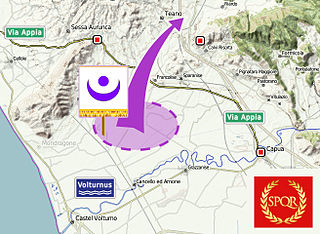 W
WThe Battle of Ager Falernus was a skirmish during the Second Punic War between the armies of Rome and Carthage. After winning the Battle of Lake Trasimene in Italy in 217 BC, the army commanded by Hannibal marched south and reached Campania. The Carthaginians ultimately moved into the district of Falernum, a fertile river valley surrounded by mountains.
 W
WThe Battle of Cape Esperance, also known as the Second Battle of Savo Island and, in Japanese sources, as the Sea Battle of Savo Island (サボ島沖海戦), took place on 11–12 October 1942, in the Pacific campaign of World War II between the Imperial Japanese Navy and United States Navy. The naval battle was the second of four major surface engagements during the Guadalcanal campaign and took place at the entrance to the strait between Savo Island and Guadalcanal in the Solomon Islands. Cape Esperance (9°15′S 159°42′E) is the northernmost point on Guadalcanal, and the battle took its name from this point.
 W
WThe Battle of Cape Matapan was a Second World War naval engagement between British Imperial and Axis forces, fought from 27–29 March 1941. The cape is on the south-west coast of the Peloponnesian peninsula of Greece.
 W
WThe Battle of Cephalonia was a naval battle fought between the Byzantine and Aghlabid fleets near Cephalonia, off the western coast of Greece. The battle was a major Byzantine victory, and one of the rare naval battles that took place during the night in the Middle Ages.
 W
WThe Naval Battle of Guadalcanal, sometimes referred to as the Third and Fourth Battles of Savo Island, the Battle of the Solomons, the Battle of Friday the 13th, or, in Japanese sources, the Third Battle of the Solomon Sea , took place from 12–15 November 1942, and was the decisive engagement in a series of naval battles between Allied and Imperial Japanese forces during the months-long Guadalcanal Campaign in the Solomon Islands during World War II. The action consisted of combined air and sea engagements over four days, most near Guadalcanal and all related to a Japanese effort to reinforce land forces on the island. The only two U.S. Navy admirals to be killed in a surface engagement in the war were lost in this battle.
 W
WThe Battle of Jutland took place in the North Sea between the German High Seas Fleet and British Grand Fleet on the afternoon and evening of 31 May 1916, continuing sporadically through the night into the early hours of 1 June. The battle was the only direct engagement between the two fleets throughout World War I. The war had already been waged for two years without any major sea battle, and many of the people present did not expect that this patrol would end differently. Lack of experience still accounted for a number of mistakes by the combatants. The battle has been described in a number of phases, the last of which is the subject of this article.
 W
WThe Battle of Kapetron or Kapetrou was fought between a Byzantine-Georgian army and the Seljuq Turks at the plain of Kapetron in 1048. The event was the culmination of a major raid led by the Seljuq prince Ibrahim Inal into Byzantine-ruled Armenia. A combination of factors meant that the regular Byzantine forces were at a considerable numerical disadvantage against the Turks: the local thematic armies had been disbanded, while many of the professional troops had been diverted to the Balkans to face the revolt of Leo Tornikios. As a result, the Byzantine commanders, Aaron and Katakalon Kekaumenos, disagreed on how best to confront the invasion. Kekaumenos favoured an immediate and pre-emptive strike, while Aaron favoured a more cautious strategy until the arrival of reinforcements. Emperor Constantine IX chose the latter option and ordered his forces to adopt a passive stance, while requesting aid from the Georgian ruler Liparit IV. This allowed the Turks to ravage at will, notably leading to the sack and destruction of the great commercial centre of Artze.
 W
WThe Night Attack at Târgoviște was a battle fought between forces of Vlad III, Prince of Wallachia, and Sultan Mehmed II of the Ottoman Empire on Thursday, June 17, 1462. The battle started after Mehmed, who already had tense relations with Vlad, discovered his alliance with Hungary's king Matthias Corvinus and ordered his forces to ambush him. Vlad foiled the attack and invaded Bulgaria. In response, Mehmed raised a great army with the objective to conquer Wallachia and annex it to his empire. The two leaders fought a series of skirmishes, the most notable one being the Night Attack where Vlad attacked the Turkish camp in the night in an attempt to kill Mehmed. The assassination attempt failed and Mehmed marched to the Wallachian capital of Târgoviște, where he found a few men with cannons. After leaving the capital, Mehmed discovered 23,844 impaled Turks whom Vlad had killed during his invasion of Bulgaria. The number is mentioned by Vlad himself in a letter to Matthias Corvinus. The sultan and his troops then sailed to Brăila and burned it to the ground before retreating to Adrianople. Both sides claimed victory in the campaign and Mehmed's forces returned home with many captured slaves, horses, and cattle.
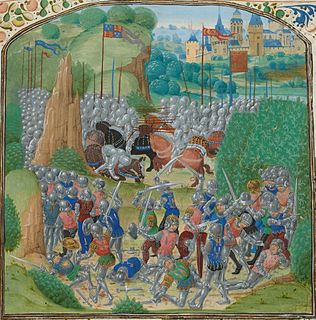 W
WThe Battle of Otterburn took place according to Scottish sources on 5 August 1388, or 19 August according to English sources, as part of the continuing border skirmishes between the Scots and English.
 W
WThe Battle of Pliska or Battle of Vărbitsa Pass was a series of battles between troops, gathered from all parts of the Byzantine Empire, led by the Emperor Nicephorus I, and the First Bulgarian Empire, governed by Khan Krum. The Byzantines plundered and burned the Bulgar capital Pliska which gave time for the Bulgarians to block passes in the Balkan Mountains that served as exits out of Bulgaria. The final battle took place on 26 July 811, in some of the passes in the eastern part of the Balkans, most probably the Vărbitsa Pass. There, the Bulgarians used the tactics of ambush and surprise night attacks to effectively trap and immobilize the Byzantine army, thus annihilating almost the whole army, including the Emperor. After the battle, Krum encased Nicephorus's skull in silver, and used it as a cup for wine-drinking. This is one of the best documented instances of the custom of the skull cup.
 W
WThe Battle of Port Arthur of 8–9 February 1904 marked the commencement of the Russo-Japanese War. It began with a surprise night attack by a squadron of Japanese destroyers on the neutral Russian fleet anchored at Port Arthur, Manchuria, and continued with an engagement the following morning; further skirmishing off Port Arthur would continue until May 1904. The attack ended inconclusively, though the war resulted in a decisive Japanese victory.
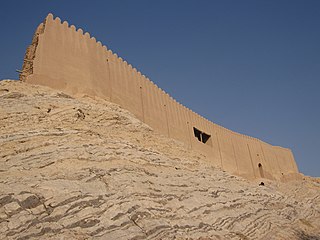 W
WThe Battle of Ray was fought between the Sasanians and the Rashidun Caliphate in 651. It was also part of the rivalry between the Ispahbudhan family and the Mihran family.
 W
WThe Sack of Rome in 546 was carried out by the Gothic king Totila during the Gothic War of 535–554 between the Ostrogoths and the Byzantine Empire. Totila was based at Tivoli and, in pursuit of his quest to reconquer the region of Latium, he moved against Rome. The city endured a siege lasting almost a year before falling to the Goths.
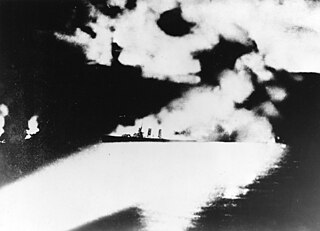 W
WThe Battle of Savo Island, also known as the First Battle of Savo Island and, in Japanese sources, as the First Battle of the Solomon Sea , and colloquially among Allied Guadalcanal veterans as The Battle of the Five Sitting Ducks, was a naval battle of the Pacific Campaign of World War II between the Imperial Japanese Navy and Allied naval forces. The battle took place on August 8–9, 1942, and was the first major naval engagement of the Guadalcanal campaign, and the first of several naval battles in the straits later named Ironbottom Sound, near the island of Guadalcanal.
 W
WThe Battle of Sept-Îles was a naval battle fought on the night of 22/23 October 1943 during World War II as part of the Atlantic campaign. The battle took place off the Sept-Îles near the French coast in the English Channel between a light cruiser and six destroyers of the British Royal Navy, and a minesweeper and torpedo boat flotillas of the German Kriegsmarine hoping to intercept and escort a blockade runner. The battle ended with HMS Charybdis being sunk and the Hunt-class destroyer HMS Limbourne being scuttled after suffering damage; nearly 500 British sailors lost their lives in the battle. The battle was the last surface fleet action of the war where the Royal Navy was defeated, and the last German surface fleet action victory.
 W
WThe Battle of Sinhagad took place during the night on 4 February 1670 on the fort of Sinhagad, near the city of Pune, Maharashtra, India.
 W
WThe Battle of Skopje occurred in the vicinity of the city of Skopje in 1004.
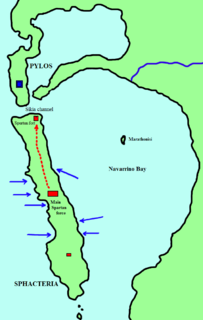 W
WThe Battle of Sphacteria was a land battle of the Peloponnesian War, fought in 425 BC between Athens and Sparta. Following the Battle of Pylos and subsequent peace negotiations, which failed, a number of Spartans were stranded on the island of Sphacteria. An Athenian force under Cleon and Demosthenes attacked and forced them to surrender.
 W
WThe Battle of Suoi Bong Trang was an engagement fought between US, Australian and New Zealand forces, and the Viet Cong and North Vietnamese Army during the Vietnam War. The battle occurred during Operation Rolling Stone, an American security operation to protect engineers building a tactically important road in the vicinity of Tan Binh, in central Binh Duong Province, 30 kilometres (19 mi) north-west of Bien Hoa airbase. During the fighting, soldiers from the US 1st Brigade, 1st Infantry Division and the 1st Battalion, Royal Australian Regiment, which had been attached for the operation, fought off a regimental-sized Viet Cong night assault. Repulsed by massed firepower from artillery and tanks, the Viet Cong suffered heavy casualties and were forced to withdraw by morning. After the attack, the Americans and Australians made no attempt to pursue the Viet Cong, focusing on securing the battlefield and evacuating their own casualties. The Viet Cong continued to harass the American sappers with occasional sniper and mortar fire, but these tactics proved ineffective, and the road was completed by 2 March.
 W
WThe Battle of the Teutoburg Forest, described as the Varian Disaster by Roman historians, took place in the Teutoburg Forest in 9 CE, when an alliance of Germanic peoples ambushed and destroyed three Roman legions and their auxiliaries, led by Publius Quinctilius Varus. The alliance was led by Arminius, a Germanic officer of Varus's auxilia. Arminius had acquired Roman citizenship and had received a Roman military education, which enabled him to deceive the Roman commander methodically and anticipate the Roman army's tactical responses.
 W
WThe Battle of the Colline Gate, fought on the Kalends of November 82 BC, was the final and decisive battle of the second civil war between Lucius Cornelius Sulla and the Marians. Sulla won and secured control of Rome and Italy. Appian is the only source who provides details about the battle.
 W
WThe Battle of Tippecanoe was fought on November 7, 1811, in Battle Ground, Indiana between American forces led by then Governor William Henry Harrison of the Indiana Territory and Indian forces associated with Shawnee leader Tecumseh and his brother Tenskwatawa, leaders of a confederacy of various tribes who opposed European-American settlement of the American frontier. As tensions and violence increased, Governor Harrison marched with an army of about 1,000 men to attack the confederacy's headquarters at Prophetstown, near the confluence of the Tippecanoe River and the Wabash River.
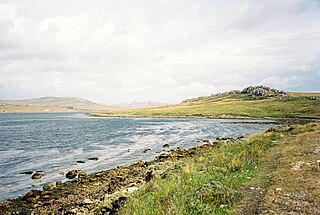 W
WThe Battle of Mount Tumbledown was an engagement during the Falklands War. Mount Tumbledown, Mount William and Sapper Hill lie west of the Falkland Islands capital Stanley and due to their proximity to the capital, were of strategic importance during the 1982 War. They were held by the Argentine 5th Naval Infantry Battalion, a reinforced, cold weather trained and equipped, Marine battalion.
 W
WThe Battle of Vella Lavella was a naval battle of the Pacific campaign of World War II fought on the night of 6 October 1943, near the island of Vella Lavella in the Solomon Islands. It marked the end of a three month fight to capture the central Solomon Islands, as part of the Solomon Islands Campaign.
 W
WThe Battle of Wauhatchie was fought October 28–29, 1863, in Hamilton and Marion counties, Tennessee, and Dade County, Georgia, in the American Civil War. A Union force had seized Brown's Ferry on the Tennessee River, opening a supply line to the Union army in Chattanooga. Confederate forces attempted to dislodge the Union force defending the ferry and again close this supply line but were defeated. Wauhatchie was one of the few night battles of the Civil War.